SEO: Beyond Rankings to Revenue
How (un)Common Logic helped an allied health college untap the potential of organic traffic for leads, increasing revenue through SEO.
- Improve the site’s visibility, authority, and offsite presence to attract visitors
- Maximize conversions by aligning marketing strategy with website content, design, and architecture
- Fix all technical issues and optimize meta content for easy search indexing
- Relaunch website for better user experience
- Keep growing visibility with smart keyword strategy
A medical college approached (un)Common Logic about increasing their lead volume. The client’s existing website traffic and lead volume was static, while their industry was growing and competitors were entering the market. Their stagnant traffic wasn’t just frustrating, it was threatening the growth of the college’s enrollments.
The client’s business was facing several complicating factors due to the nature of the allied health industry:
- Recent industry growth meant that many new competitors had entered the market
- The industry was (and still is) subject to many levels of state and federal regulation, some of which dictated and/or limited marketing messaging
- Additionally, those regulations could change at any time
The website’s purpose was to guide visitors through the conversion process based on their desired degree or career. A “complete conversion” would occur when a prospective student completed a contact form, scheduled a meeting with an advisor, and finally enrolled in an allied health or nursing program.
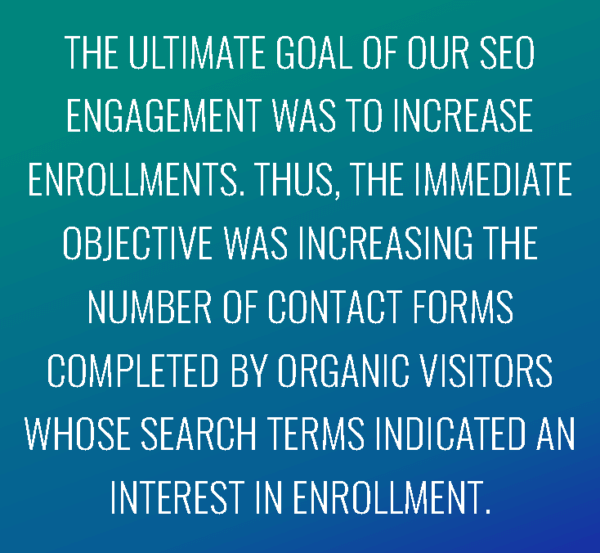 The ultimate goal of our engagement with this client was to use SEO to increase complete conversions. Thus, the immediate objective was increasing the number of contact forms completed by organic visitors whose search terms indicated an interest in enrollment.
The ultimate goal of our engagement with this client was to use SEO to increase complete conversions. Thus, the immediate objective was increasing the number of contact forms completed by organic visitors whose search terms indicated an interest in enrollment.
When we started working with them, the form completion rate from organic traffic was a mere 1.97%. Part of the problem was lack of engagement:
- 64% of organic visitors stayed on the site for 10 seconds or less
- Another 6% of all organic visitors left before spending 30 seconds on the site
- 75% of all organic visitors viewed only one page on the site
After studying their data, we determined that a visitor who stayed for more than 30 seconds and viewed more than two pages had a significantly higher likelihood of submitting the lead form.
Since only 25% of organic visitors stayed 30 seconds or viewed even a second page, our challenge was clear.
Audit
The client engagement began with an in-depth audit of their website’s code, organization, content, and user experience. We also examined their offsite presence, including social profiles and backlinks. And most importantly, we analyzed their goals and strategy for SEO, investigated the competitive landscape, and conducted thorough keyword research.
Through our years of experience in optimization, we have developed a model of an ideal SEO approach:
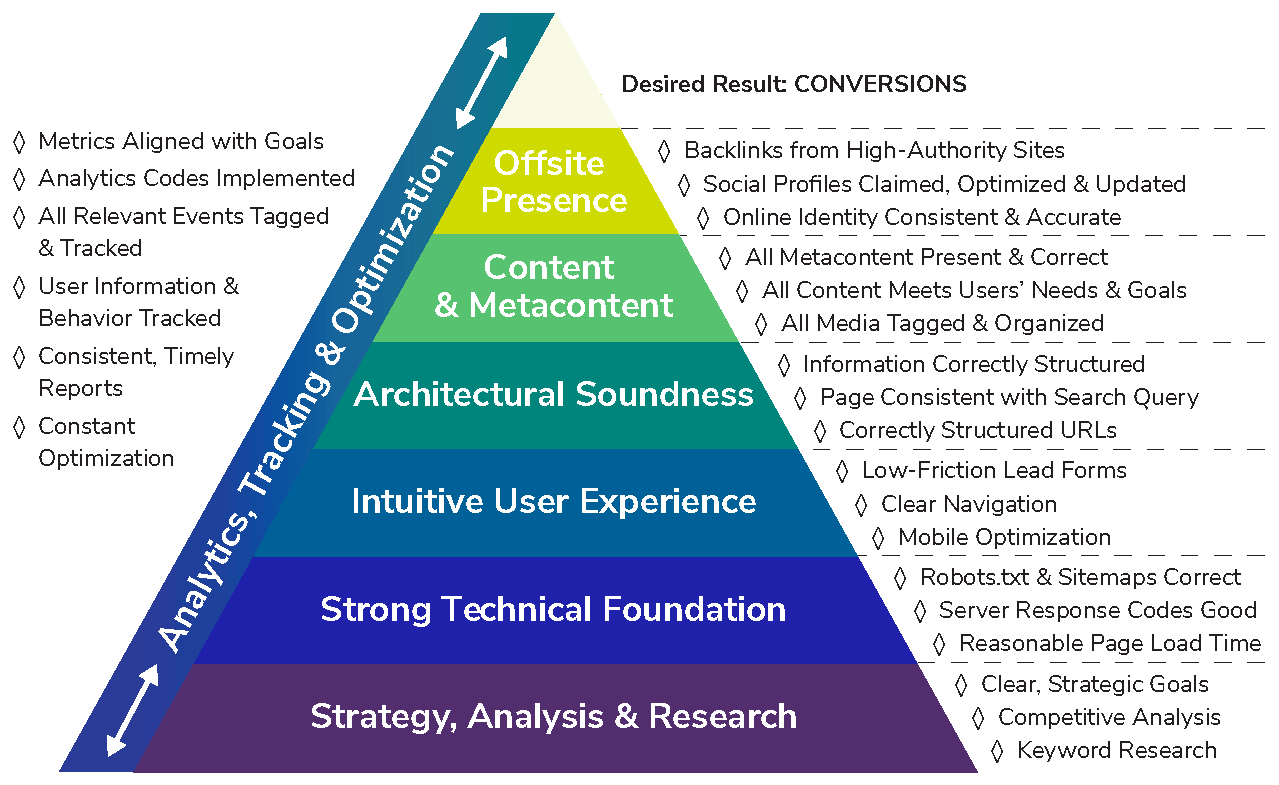
Our 133-point (at the time) SEO audit revealed that the site’s server codes were good: no server-level crawler errors, only one 404 error, and all 301 redirects were properly implemented.
However, other technical, architectural, and content areas had significant room for improvement:
- Duplicate content and improperly implemented canonical tags damaged the site’s rankings and likely confused visitors
- Their XML sitemaps were incomplete and not up-to-date, harming their technical SEO status
- Significant meta content issues meant that the site wasn’t sending the right signals to search engines—or to searchers
- The site’s architecture didn’t consistently support conversion goals or a good user experience
The site’s organic traffic indicated gaps between marketing strategy and SEO execution:
- Only 20% of overall traffic was organic
- Almost all traffic was driven by branded terms—specifically, legacy brand terms that didn’t match the client’s current brand, position, or offerings
- Generic/non-brand terms enjoyed some visibility, but were not generating significant traffic
Perhaps the most damaging thing we found concerned the client’s visibility to a crucial audience. The site wasn’t sending strong local signals to search engines, and much of the client’s local information was missing or inconsistent. Because most of the school’s students were local, these gaps were directly hurting conversions and revenue among the school’s main customer base.
Phase One: Fast Fixes
SEO is a long-term endeavor, but during this phase, we implemented changes that would affect organic traffic in just six months. We focused on four elements that would yield the greatest results in a short time.
- Optimizing meta content for search
- Reducing navigational friction that prevented users from completing conversion actions
- Implementing end-to-end analytics for more accurate tracking of goal completions
- Optimizing the client’s local information and online identity
Meta Content Improvements
Meta content is one of the best places to make quick SEO improvements by correcting inaccurate signals.
Meta content problems
When we began working with the client, their meta content had significant issues:
- 13% of pages had no meta titles
- Another 13% of pages had duplicate titles
- 25% of pages had titles that were too long
- Page titles were not targeted to actual product offerings
- All page (non-blog-post) titles included the client’s old name
- 63% of pages had no meta description, including almost all blog posts
- Most pages with meta descriptions had the client’s new name, but all these pages had the old name in the title tags
- Calls to action in meta descriptions, when present, were weak
- 6% of meta descriptions were too long
The site’s average click-through rate for its organic keywords over the previous quarter was 3.36%.
Meta content activities
Our focus on the client’s value proposition that aligned with a key brand statement gave us a clear directive for improving the site’s meta content. We made these changes in less than one month:
- All titles included relevant keywords
- All titles aligned with content and product offering
- All meta descriptions incorporated a brand value proposition statement
- All meta descriptions had a clear CTA
- All meta descriptions fit within character limits
Meta content results
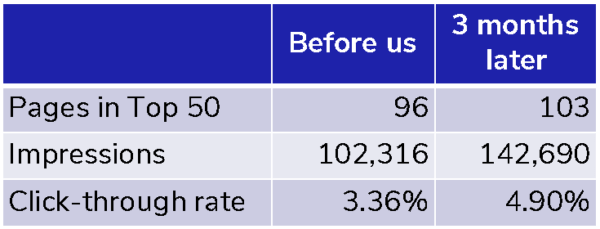 Three months later, the site’s average click-through rate for its organic keywords was 4.90%, a gain of 37.5% in just three months.
Three months later, the site’s average click-through rate for its organic keywords was 4.90%, a gain of 37.5% in just three months.
Also during that time, the number of pages ranking at position 50 or higher increased by 7.3%, and the total impressions for those pages increased by 39.5%.
Analytics and Tracking
Thorough, consistent tracking doesn’t just provide data to prove that SEO efforts have worked; it also provides data that SEO experts can analyze to identify opportunities for further improvements. Because our approach to digital marketing is driven by data, not by hunches, we perform these analytics optimizations for every client:
- Assess all Google Analytics profiles, properties, and view settings/filters
- Establish business-oriented goals and events to track on the website
- Determine the best ways to segment data for insights into key subsets
- Implement settings, filters, goals, events, and segments, and optimize them on a regular basis
- Create automatic reports to focus on relevant metrics that indicate performance toward client-specific goals
Local Information
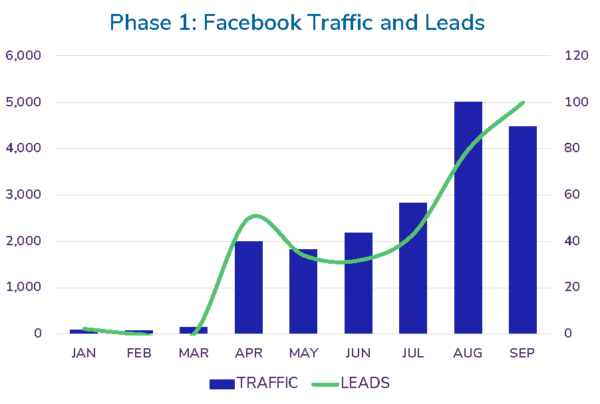 Most of the client’s target audience were young women considering a career change or looking to improve their lives. They spent a great deal of time on Facebook, so having accurate listing information and an optimized business page was essential for the client. We assisted them in applying these best practices:
Most of the client’s target audience were young women considering a career change or looking to improve their lives. They spent a great deal of time on Facebook, so having accurate listing information and an optimized business page was essential for the client. We assisted them in applying these best practices:
- Accounting for all locations on one central business page
- Using Facebook categories to assist in platform searches
- Populating the “Products” section of the page with degree programs
- Optimizing the page’s cover image to include photos of people in the jobs for which the client offered degree programs
These improvements were made in March of Year 1, and the resulting growth in traffic and conversions from Facebook proved the value of optimizing the business page.
We ensured that the client’s listing information (location, phone numbers, website URL, hours) were consistent across all major directories and information sites. We also helped the client add a short description about the school, a short description of each campus, and more/newer photos to each campus’s Google+ local pages.
Phase 1 Results
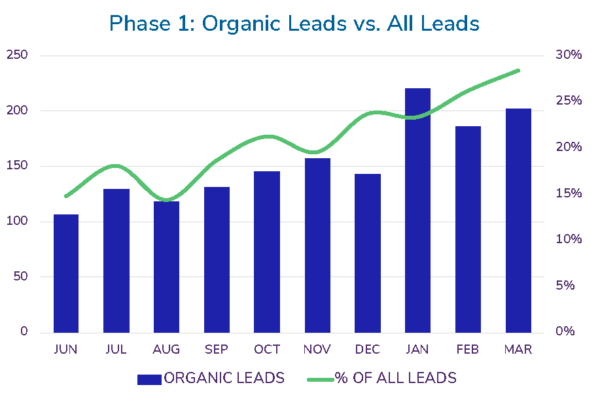 By making simple, yet powerful, improvements to the website, we generated very quick results. More pages ranking at position 50 or higher meant more visibility for the client’s site, more impressions (i.e., people seeing their listings), and higher click-through rates.
By making simple, yet powerful, improvements to the website, we generated very quick results. More pages ranking at position 50 or higher meant more visibility for the client’s site, more impressions (i.e., people seeing their listings), and higher click-through rates.
And the results of higher visibility were clear, as organic lead volume grew and SEO-generated leads became nearly 30% of the site’s total leads. As the proportion of leads generated by SEO grew, the proportion of leads generated by paid search advertising decreased, so that while total lead volume grew, the average cost per lead declined.
Phase Two: Website Relaunch
The client’s site had undergone a redesign when they rebranded, but that redesign focused mostly on replacing the name and logo throughout the site, with a few cosmetic updates. We recommended a full site relaunch, to address back-end technical and architectural issues as well as improve user experience and content development.
Goal and Strategy Alignment
We began the relaunch process by advising the client on strategic alignment for the website. A perfectly optimized website is of no value if it doesn’t align with, support, and promote a company’s marketing strategy, so this is a crucial first step. The visual design work was performed by an outside firm; we consulted with them throughout the redesign to ensure that every element of the site aligned with client goals.
The client had introduced a nursing program the previous year; it was their most advanced degree program yet, and they wanted to promote it. The site rebrand hadn’t helped ith that goal; in the quarter before our engagement, the client was visible for 0% of their target keywords related to nursing. Thus, our relaunch gave extra emphasis to the nursing program, as well as focusing the overall website on lead generation.
Technical Function
Our technical relaunch preparation focused on reducing page load time for better user experience, fixing broken links to improve the site’s legitimacy in the eyes of search engines, and mobile optimization, as this relaunch included responsive design and mobile-friendliness.
Page load times
We attacked long page load times from two angles:
- Advising the site design and development team on the best ways to get their desired visual effect with a minimum of unnecessary code and scripts
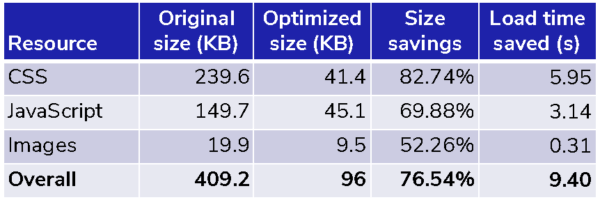 Optimizing design and development assets to further reduce their load times:
Optimizing design and development assets to further reduce their load times:
- Compressed CSS elements, reducing their transfer size by 83%
- Relocated and/or optimized render-blocking content such as plugins and fonts
- Compressed and properly formatted images, reducing their transfer size by 53%
As a result, we were able to reduce the total size of these assets by 77% and reduce page load speed by an amazing 9.4 seconds.
Broken links
An external link audit found that 127 pages had broken links, nearly all of which stemmed from a defunct blogging platform the client had used. By making this one site-wide change, we improved the site’s “authority” in the eyes of search engines.
Mobile optimization
The client’s previous site had not been responsive, resulting in a very frustrating experience for prospective students on mobile devices. This was especially damaging because the client’s target market consisted almost mostly of women age 19-25 eager to improve their lives and thus future-oriented. At the time of the relaunch, 85% of young adults owned smartphones, with 60% of that group using mobile devices as their primary internet device (the numbers and proportions have since grown).
By making every page on the website mobile-friendly with a mobile performance score of at least 66 (a “C” or better in Google PageSpeed Insights’ ratings), we essentially increased the client’s online audience as well as the likelihood that audience members would stay on the client’s site once they accessed it from a mobile device.
Architecture and User Experience
Here, we focused on making the user experience (UX) as seamless as possible. That meant optimizing the site organization, hierarchical site map, path flow, URL structure, keyword mapping and internal links.
In the site’s main navigation bar alone, we made several changes:
- We relocated some categories to the site footer or its upper right-hand corner:
- “Employers,” which didn’t address the prospective student audience
- “Career Advice,” which didn’t direct prospective students toward lead-oriented content
- Site search, which is important, but wasn’t a hierarchical match for the other nav bar categories
- We consolidated several client-focused categories; “Blog,” “Locations,” and “About Us” became subcategories under “About [Client] College” (location information was also duplicated in the site footer)
- We moved the “Nursing” program category from the leftmost position on the nav bar to the second-from-left position because heatmap data indicated that the inner spot got more attention than the outer spot
- We renamed crucial categories and made the most crucial category name into a call to action:
- “Testimonials” became “Student Success Stories”
- “Contact Us” became “Request Information”
- “Admissions” became “Enroll Now”

We also changed the site’s link structure during the relaunch. Previously, blog posts had a URL of blog.clientsite.edu, a subdomain, rather than www.clientsite.edu/blog/, a folder within the primary domain. This resulted in a literal doubling of the work involved to track and monitor blog post performance.
Phase 2 Results
The goal of (un)Common Logic’ SEO team is to improve the volume and quality of organic traffic, thus improving organic leads. However, the goal of (un)Common Logic as a company is to help our clients grow their business overall, which means growing all leads.
The relaunch accomplished both: boosting organic leads significantly, while increasing lead volume from all other sources as well. A well-designed, lead-gen-oriented website is truly a rising tide that lifts all boats.
We saw these results:
- Total lead volume increased by 223% year over year, while organic lead volume increased by 233% in this time
- Year over year, the overall conversion rate increased by 93%; for non-organic leads, it went up by 79%; for organic leads, it increased by 164%
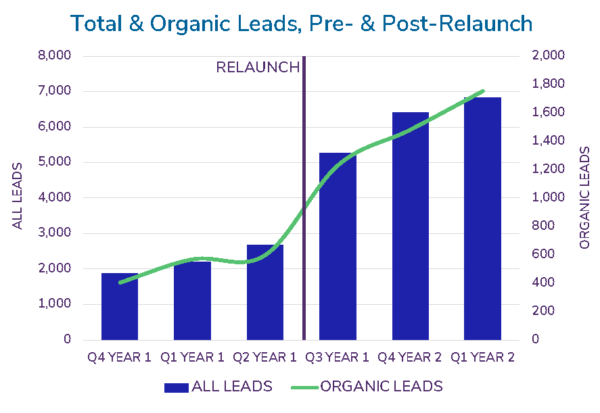
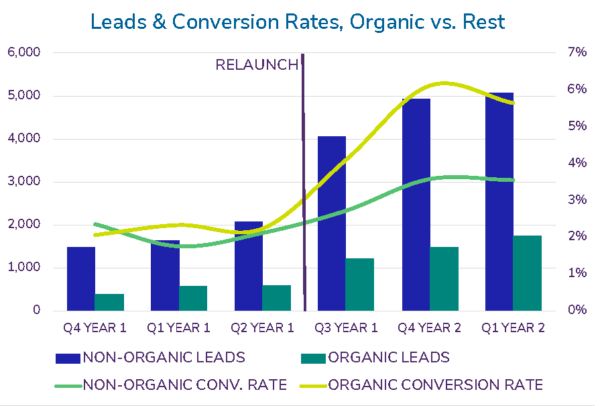
Phase 3: Ongoing Optimization
Our engagement with this client was for a limited time only. The initial contract was for a year, but the client requested another six months to ensure the gains they made with us would continue to accrue. We were happy to accept, as this would give us a chance to make further optimizations post-relaunch and to give the client’s in-house team the training and documentation they’d need to continue these optimizations on their own.
Keyword Visibility
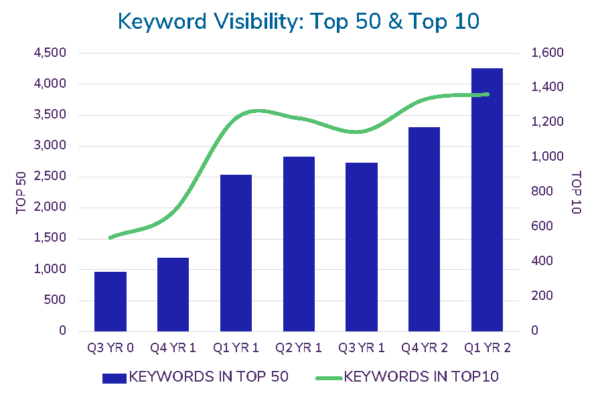 We kept researching and refining keywords to target based on traffic and conversion data. A set of targeted keywords should not be static; it should evolve as a client’s business, industry, and market change and evolve.
We kept researching and refining keywords to target based on traffic and conversion data. A set of targeted keywords should not be static; it should evolve as a client’s business, industry, and market change and evolve.
Keyword visibility more than quadrupled during our engagement, with some of the biggest gains made after the relaunch. The total number of keywords for which the client was visible on the first 5 pages of search results increased by 56.7% and the number of keywords the client had top-10 visibility for increased by 18.7%.
Matching Landing Pages to Searcher Intent
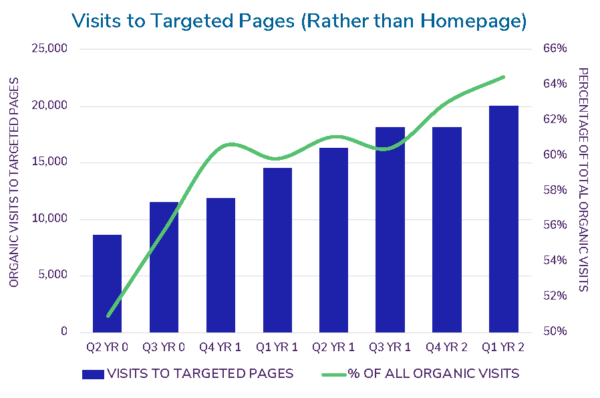 Prior to the relaunch, a user who clicked on the client’s listing in organic search results was usually taken to the site’s homepage, rather than the page that answered their specific query. They would then have to navigate through multiple pages on the site before finding the answer to their question. This type of friction often leads to an increased bounce rate and lower conversion rate.
Prior to the relaunch, a user who clicked on the client’s listing in organic search results was usually taken to the site’s homepage, rather than the page that answered their specific query. They would then have to navigate through multiple pages on the site before finding the answer to their question. This type of friction often leads to an increased bounce rate and lower conversion rate.
After implementing the appropriate technical and architectural changes, users were taken directly to the page that addressed their query. In other words, they got what they were looking for much faster, without friction, improving their overall experience on the site.
We achieved this by mapping page URLs to the queries each page was best matched to, then optimizing pages for those queries. We continued improving query-to-URL matches after the relaunch, and increased the proportion of organic visits to targeted pages rather than the homepage by a further 7%.
Final Results
Visibility
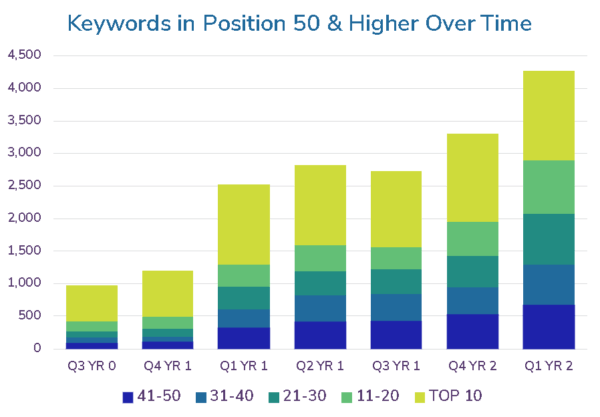 The total number of keywords ranked at position 50 or higher more than quadrupled, going from 967 to 4,262 over six quarters. Keywords ranked in the top 10 more than doubled during that same time, with a final count of 1,364 top-10 keywords.
The total number of keywords ranked at position 50 or higher more than quadrupled, going from 967 to 4,262 over six quarters. Keywords ranked in the top 10 more than doubled during that same time, with a final count of 1,364 top-10 keywords.
Organic Traffic and Leads
In our 18-month engagement with the client, we saw these results:
- Quarterly organic traffic volume increased by 66%
- The quarterly volume of organic-generated leads increased from 155 to 772, growing by almost 5 times
- When the new site was launched in Q3 of Year 1, lead volume more than doubled in just one quarter, going from 263 to 541
- The organic conversion rate went from a monthly average of 2.1% in the six months prior to our engagement to a monthly average of 5.6% in the final three months of our engagement
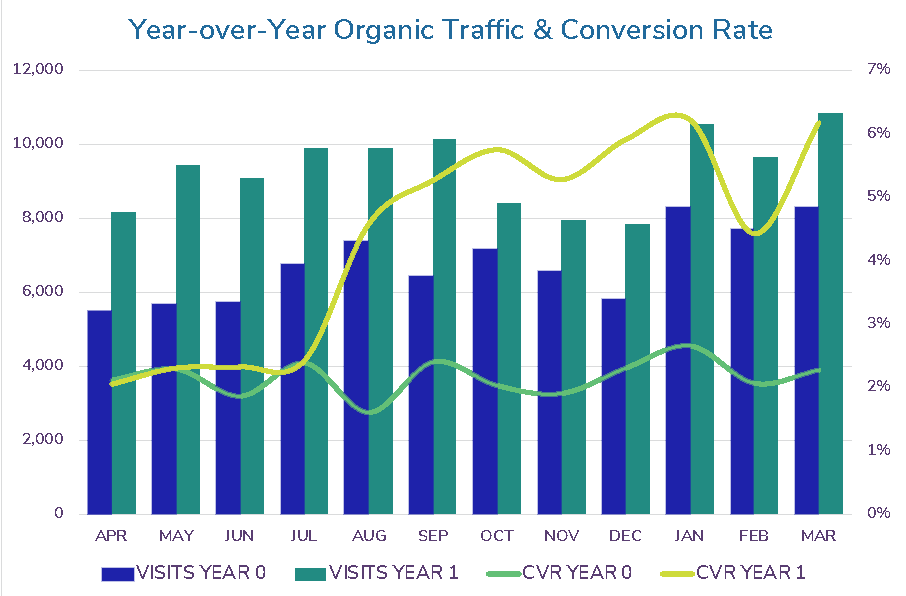
Takeaways
SEO isn’t a “nice-to-have” or a set of tools and tricks that only affect your site’s code. It’s one of the fundamental pillars of your marketing strategy, and supports your business strategy as well. Good SEO encompasses every aspect of a website, from its code to the tone and style of its content, and many off-site aspects as well, such as online identity. When SEO is focused on meeting user needs to facilitate conversions and informed by regularly updated data, organic traffic can be a major revenue driver. This case captures several essential points of our SEO philosophy.
Never lose sight of the important metrics
High position rankings are great for visibility, but it’s just as important to optimize your website and content to maximize the return on the increased traffic. After all, traffic by itself won’t grow your company.
Invest the time, reap the rewards
In most cases, it takes time to see the results from SEO. Significant growth can take anywhere from 6 to 12 months, depending on the technical and architectural quality of your existing site. However, that growth will be consistent and long-lasting, because it’s based on user needs.
Always be testing and optimizing
Never settle for “good enough” or “what worked before.” Keep seeking ways to improve performance, optimize the user experience, remove friction from the buying process, and introduce beneficial innovations. If you want to learn more, consider our conversion rate optimization services.

